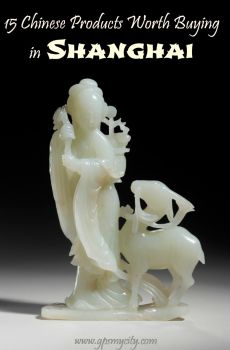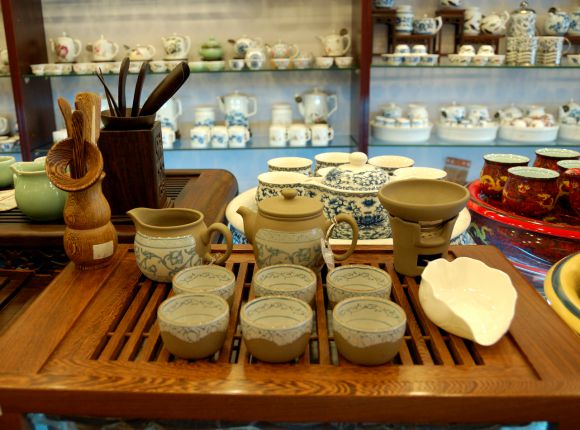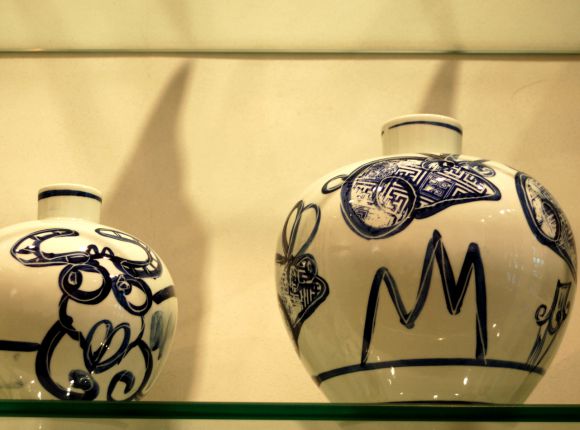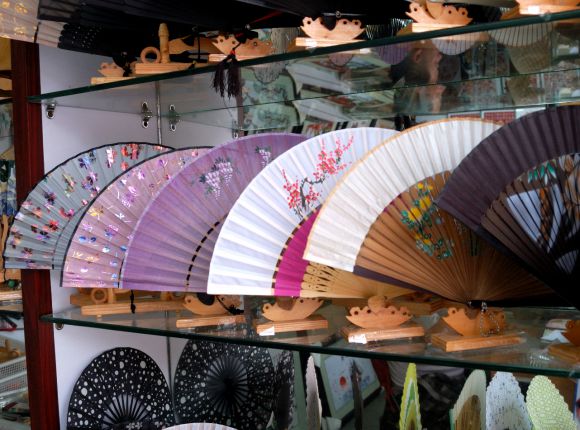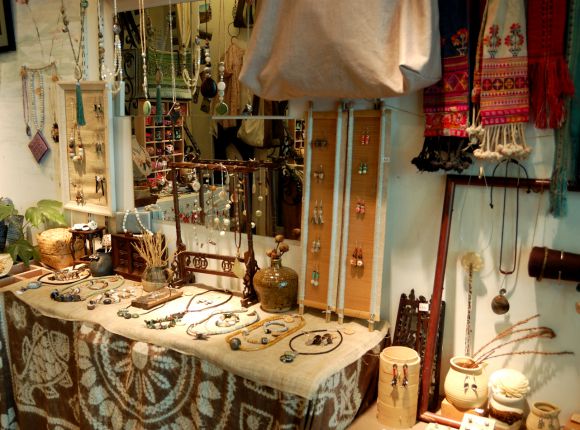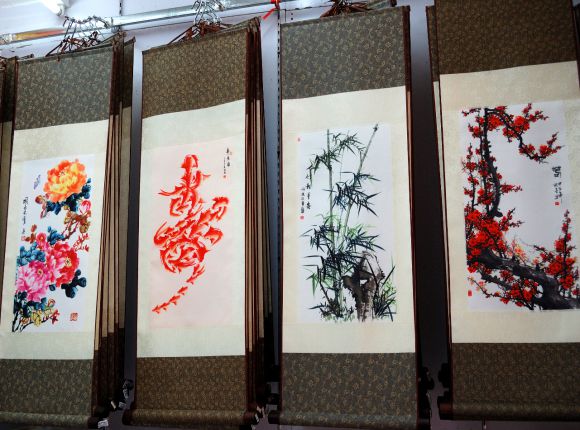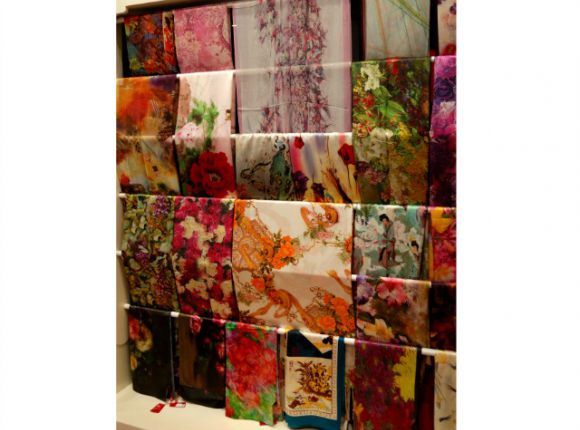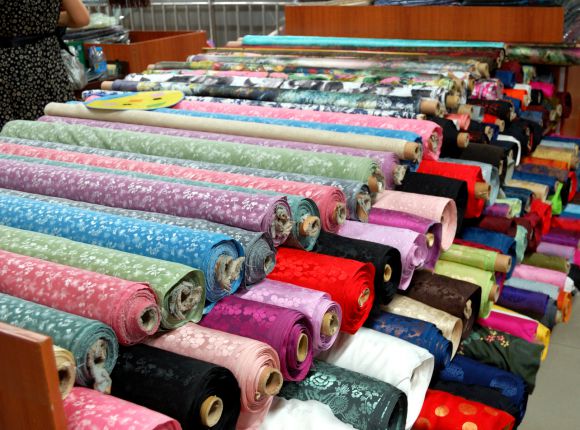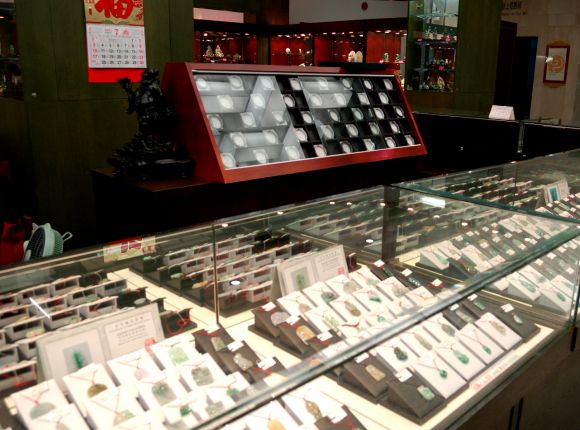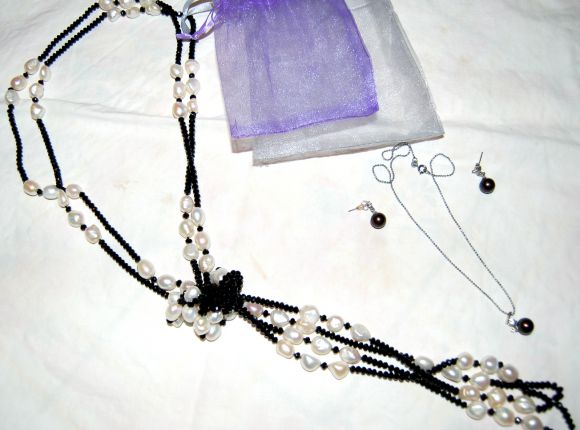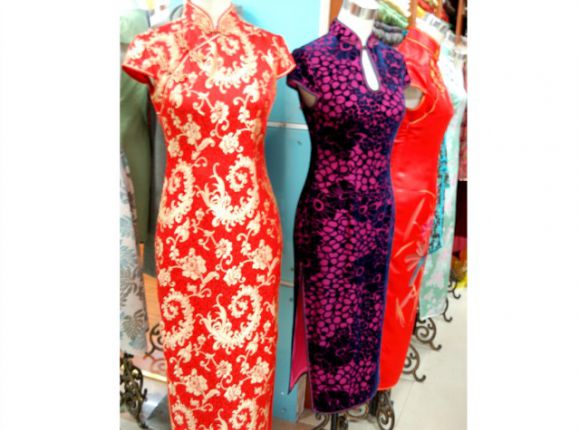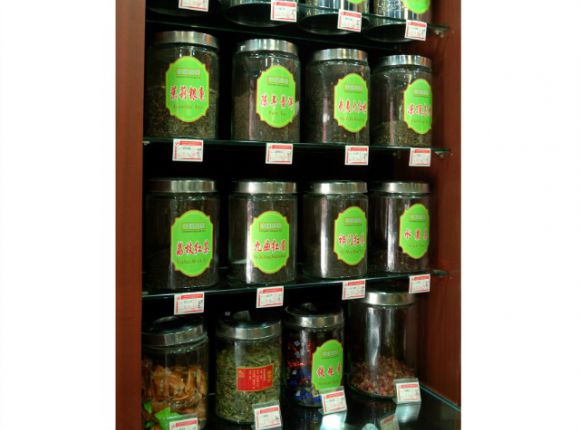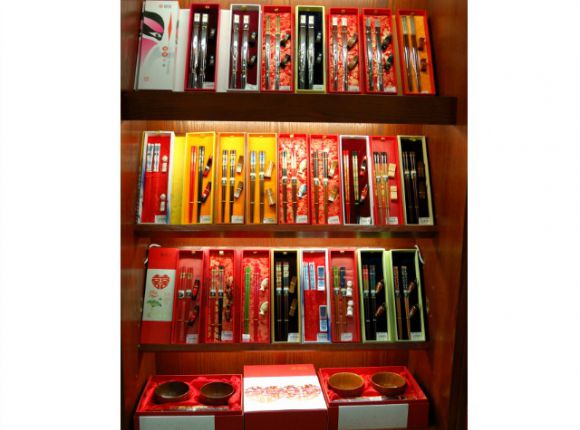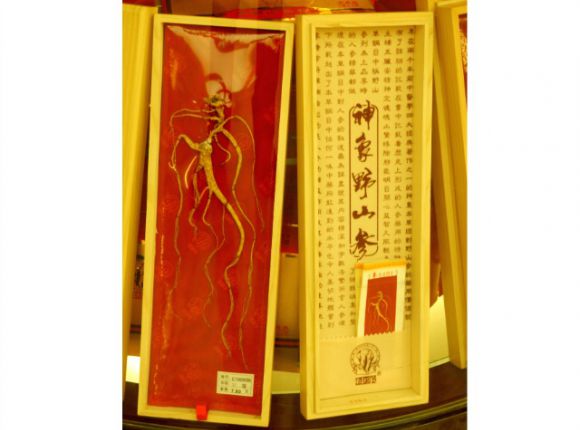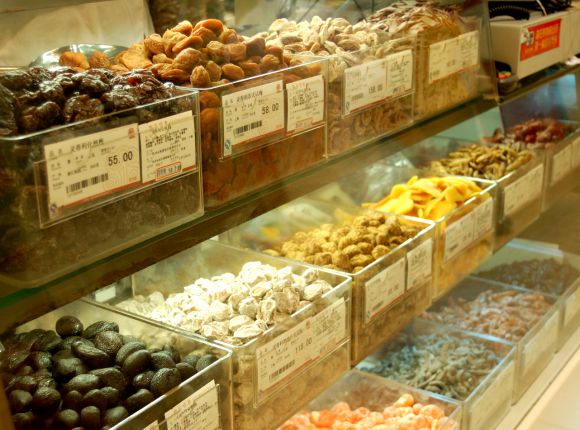1. Tea Sets

In order to fully enjoy a cup of tea, it needs to be properly made, and Chinese sets are the best tools for enhancing the scents and tastes of tea. Apart from being beautifully decorated, tea sets vary in size and the number of items included. A basic set consists of a tea pot with a filter inside and six cups of typically round shape. A professional tea set is a perfect gift for those truly passionate about the art, history and tradition of tea making. A professional tea set comprises different items, primarily - one of the key elements - the bottom table with holes connected to a pipe, so that the water used to clean up or for the first tea can easily flow underneath. The teapot for a professional set is usually rather expensive and is made either of ceramics or terracotta. The cups are tiny and the tea is poured into them many times so as to allow its scent and taste to be released little by little. Prices vary remarkably, from Y28 for a simple teapot up to Y10,000 for the one made of Chinese clay, also known as Purple Sand (Yi Xing, 宜兴). A whole tea set can go for between Y89 and Y1500 for a more professional one.
With tea being an important element of the Chinese tradition, it is possible to find tea sets almost anywhere throughout Shanghai. However, in order to find a decent complete set, it’s better to go to a specialized shop.
Buy It on Amazon:
Offline reading and travel directions:
With GPSmyCity App you can read this article offline on your mobile device, use the embedded offline city map and GPS navigation, as well as create a self-guided walk to visit the venues featured in the article.
2. Ceramics
Along with silk, ceramics and porcelain have been in use by the Chinese for thousands of years. Hand-painted pottery, tiles and other sorts of Chinese ceramic-ware make for elegant gifts that will definitely be appreciated. Worldwide famous, Chinese ceramics is available in different colors, which is usually subject to the area they are made in. Many provinces, in fact, produce pottery and in Shanghai it is possible to find them all, both created by modern designers and those dating back to the Qing dynasty. Pots, tea sets, plates and cups of every shape and color are widely available in many places, from tourist markets to small local shops. The offered range is diverse: from a Y10 chopstick holder to a Y6,800 separator or even a fancy Y150,000 butterfly outfit, entirely handmade porcelain decoration, to hang on the wall.
A famous store that sells high-quality porcelain is The Pottery Workshop whose outlets are also found in Beijing, Hong Kong and Jindezhen.
Where to find it:
The Pottery Workshop
Address: 220 Taikang Road
Address: 176 Fumin Road
Buy It on Amazon:
Offline reading and travel directions:
With GPSmyCity App you can read this article offline on your mobile device, use the embedded offline city map and GPS navigation, as well as create a self-guided walk to visit the venues featured in the article.
3. Fans
Symbol of femininity, fans were widely used by concubines during the royal periods, both to give some relief during the hottest hours of the day and as an essential accessory comparable with a piece of jewelry. Today, they are still used in hot summer months, although they are not all as finely decorated as they used to be during the imperial era. Fans come at different prices, depending on the quality of the material and whether or not they are handmade. They can be made of silk and hand-painted with typical Chinese patterns of natural objects, such as birds, landscapes, mountains, lakes, etc. Fans make for a nice gift that is particularly appreciated during the hot season. The initial price for a fan is around Y20, but it can vary depending on the quality of the material. You can also order one made to your taste and the artisan will duly address your specifications.
Buy It on Amazon:
Offline reading and travel directions:
With GPSmyCity App you can read this article offline on your mobile device, use the embedded offline city map and GPS navigation, as well as create a self-guided walk to visit the venues featured in the article.
4. Handicrafts
In China, there are fifty-six minority groups, all with their own culture and crafts. In Shanghai you can buy handicrafts from all over the country; particularly impressive are the works from Tibet, but also northwestern Xingjian province with predominant Muslim population, or southwestern Guizhou province. Local jewelry, traditional shawls, artful sewing, and the paper made of seasonal leaves used for writing or as a lamp cover - all these items make for a very original gift and vividly present the complexity of today's Chinese society. Colorful scarves, finely decorated silver bracelets, all the shops selling local handicrafts bring their products directly from the original source, buying them from local artisans. The wide price range gives everybody a chance to find a suitable gift: from the Y50 for a bracelet or Y60 for a wine cup up to Y20,000 for a masterly made sewing decoration.
Where to find it:
Yue shop
Address: 28 West Fuxing Road
Buy It on Amazon:
5. Art Objects

Typical handmade paintings and miniatures, featuring birds, cities and villages, with even a smallest detail meticulously taken care of, make for a very classy gift that pays homage to the ancient Chinese art. In Shanghai, you can find galleries selling paintings from renowned contemporary and ancient artists, as well as small galleries displaying works of minor painters. Alongside paintings on silk and canvas, there are embroidery works that take from three to six months to complete (as opposed to regular paintings usually taking one month). If you want, you can bring a picture of your own and the artists will copy it into a painting. At a small showroom of local artists, prices can vary from Y30 to Y1500, depending on the size and the quality of the material used. Landscape painting is considered top of the list, hence there are countless canvases, featuring spectacular views with rolling hills and mountains, as well as surreal lakes and rivers, coming from all over China.
If you don’t mind spending a bit more and want to buy a painting from one of today’s most renowned artists, make it to Duoyun Xuan Art Shop, where you can find works by Zhang Da Qian, Wu Chang Shuo, Jiang Han Ting, Zhou Hui Jun - all the big names on today's China's painting scene. Prices vary consistently, from Y3,500 to Y2,500,000 for a work by Zhang Da Qian.
Where to find it:
Duoyun Xuan Art Shop
Address: 422 East Nanjing Road
Opening hours: Daily: 9:30am - 9pm
6. Silk

As an ultimate point of departure of the ancient Silk Road, China is the best place to buy this precious fabric. Different quality of silk makes difference in its price. Silk of all colors and qualities is undoubtedly a beautiful gift from China, where it's still being produced on a large scale by government-run factories. The production process involves artisans handpicking every cocoon and putting them into a spinning machine to untangle, upon which they take the thin thread to work. All over China, from silk factories to specialized stores, you can find fine silk products of numerous varieties, including dresses - both Western and Chinese style, shawls, wonderful bed sheets and quilts, or buy the fabric per meter. Prices differ and everybody can find something suitable, befitting their pocket: Y500 for a silk dress or Y90-Y180 per meter of fabric, depending on the quality. At local markets, prices are usually negotiable.
Undoubtedly, the best place to buy silk is the factories, and the closest one to Shanghai is in Suzhou water town, 45 minutes by train. Still, those who can’t make it there, can find everything in Shanghai. In the city center, there is a large store of Silk King chain where you will find every silk product imaginable. If you feel like bargaining, head to Shi Liu Pu Cloth Market, not far from the Old Street, where silk is sold in every stall; you can also find stalls specializing solely in silk.
Where to find it:
Silk King
Address: 66 East Nanjing Road
Shi Liu Pu Cloth Market
Address: 168 Dong Men Road
Buy It on Amazon:
7. Sweets
Most Chinese have a sweet tooth, hence the presence of sweetness in many local dishes; this also explains why there's usually no dessert offered after a meal in China. Still, the traditional cooking of China abounds in cookies, sweets and snacks of various sort, comprising among others dried fruits, sunflower and watermelon seeds, tasty peanut brittle and most popular sun cakes. Peanut brittle is a typical Chinese sweet featuring natural roasted or candied peanut. Sun cakes - round pastries filled with maltose, condensed malt sugar - are often sold prepackaged in gift boxes for tourists. Their counterparts - moon cakes - are just as popular and represent round or rectangular pastries filled with lotus seed paste. They are particularly popular during the Moon Festival (hence the name) in Mid-Autumn, which is one of the most important festivities of the Chinese calendar. Sweets, cakes and dried fruits are typical gifts from China and very easy to pack when traveling.
Where to find it:
Shanghai's N.1 Store
Address: 830 East Nanjing Road
Buy It on Amazon:
8. Fabrics

Apart from the traditional silk, Shanghai is rich in many other fabrics, available at affordable prices. There are markets solely devoted to fabrics, where you can buy material for tailoring or order pieces to be made, or even buy ready-made garments, including traditional cheongsam (Chinese dress). The choice of fabrics is enormous and includes, apart from silk, linen, cashmere, and mixed fabrics of different combinations. Buying at a local market is normally associated with heavy bargaining (highly recommended, particularly if you are a first-time visitor) as the prices are never fixed but tend to change day-to-day (usually higher on weekends and during high seasons). Half silk-half linen sold by meter costs around Y50. Cashmere is usually more expensive, especially if comes from Mongolia. A tailor-made cashmere dress or a jumper can be bought for between Y600 and Y900.
Traditionally, the best places for fabrics are Shi Liu Pu Cloth Market and the huge South Bund Fabric Market). A bit far from the city center, this market is quite popular with expats, and offers a complete choice of locally-produced fabrics.
Where to find it:
Shi Liu Pu Cloth Market
Address: 168 Dong Men Road
South Bund Fabric Market
Address: 399 Lu Jia Bang Road
Buy It on Amazon:
9. Jade
Jade is the national pride of China, largely seen as more than just a stone, but a substance fit to bring luck, ward off evil spirits and possessing healing powers (particularly beneficial to heart) if worn on a wrist as a bracelet. This is why jade is valued not only as a beautiful piece of jewelry or object of art, but also as an essential symbol of local culture. It comes in three colors: green, white and purple. Green jade is the most popular and supposedly the best type; within itself it is graded by different shades of green - the darker the better. Prices vary consistently, depending on the quality, color, size and, of course, type of jewel. A typical set of necklace and earrings can go for anything between Y70 and Y200, but the highest quality jade can command a price of up to 30,000 Yuan for a pendant alone.
Where to find it:
Hongqiao International Pearl City
Address: 3721 Hongmei Road
Buy It on Amazon:
10. Pearls
China is the world's largest producer of pearls and buying beautiful necklaces and earrings here is much cheaper than anywhere else. There are several types of natural pearls; fresh water ones are usually of lower quality and are much cheaper; those from the sea (South Sea) are higher in quality and, subsequently, more expensive. The difference in price is also due to the pearl's size, shape and color. Perfectly round pearls are harder to find and, hence, they're more expensive. Natural pearl colors, apart from the most common white, are peach, pink, grey, black and golden. Beautiful black and, especially golden, pearls come only from the sea.
Identifying real pearls is easy: just scratch it with scissors or your own teeth - some fine white sand would come off, but when you wipe it off, the pearl would appear undamaged. Prices vary considerably, from some Y60 for a set of necklace and earrings of fresh water pearls to Y1000 for a single big golden pearl from the South Sea.
Where to find it:
AP Xinyang Fashion & Gifts Market
Address: underground in the Science and Technology Museum metro station on line 2, 2002 Century Avenue
Hongqiao International Pearl City
Address: 3721 Hongmei Road
Helen's shop
Address: 2nd floor, Room B001, Hongqiao International Pearl City, 3721 Hongmei Road
Buy It on Amazon:
11. Traditional Clothes and Shoes
Although the widespread stereotype of a Chinese dress is usually associated with sensual cheongsam, in reality, traditional Chinese clothing is very diverse due to the presence of fifty-six ethnic groups in the country, each with their own traditions, colors, fabrics and styles, differing between provinces and vividly reflective of the great variety and complexity of the Chinese society. Strictly handmade and mostly vegetable-dyed, the traditional clothing, accessories and shoes on sale are either produced by a certain minority group or represent collections created by modern designers inspired by certain ethnic minorities. The most commonly used fabrics are silk, cotton and linen. Quite often the colors of clothes, shoes, shawls and accessories are bright with dominant blue and white patterns originated in Jiangsu, Zhejiang and Guizhou provinces. Prices on national clothing go from Y100 to Y2000, and Y480 to Y1200 for handmade silk shoes.
Where to find it:
Urban Tribe shop
Address: 105 Songshan Road
Suzhou Cobblers
Address: 17 Fuzhou Road, Room 101
Buy It on Amazon:
12. Chinese Tea

The Chinese have been drinking tea for thousands of years and to such an extent that the habit has become a true form of art. There are many varieties of tea available, each with their individual characteristics, taste, color and curative properties. The main categories are green, black (also known as “red tea”, hong cha, 红茶), Oolong and flower tea. The quality of tea depends heavily on its cultivation process; the best sorts are said to be coming from the mountain regions. Strongly anti-oxidant green tea, such as the famous Dragon Well, produced near Hangzhou, is very highly valued. One of the most popular teas in China today, thanks to its purifying and slimming properties, is black Pu’er. Sweet for Asian taste, Pu’er tea can be bitter to Western palates, but despite its strength, it’s not overly energizing, so it can be drunk in the evening. Part of the Oolong category is the Tie Guanyin tea, produced in Fujian province, renowned for its lovely smell and great taste. It doesn’t have much curative power and is recommended during winter as a body warmer. Prices can go from Y20 to Y220 per 50g of the highest quality green tea.
13. Traditional Souvenirs

China abounds in original souvenirs closely linked to its ancient civilization and traditions; Shanghai alone offers a wide choice, including handmade chopsticks, Mao's era memorabilia (e.g. Chairman’s cups or socialist period posters), other unique objects providing precious insight into the country's rich history and culture. In China chopsticks replace forks and knives, and some of them are truly sophisticated pieces of art. Another typical traditional souvenir, with a great deal of artistic touch, is a piece of calligraphy (traditional characters brush- painted in ink) that turn simple writing into a precious painting worth being displayed. Along with calligraphy works, you can buy the actual tools for that as well - this would make a nice gift for collectors. There is something for any budget on sale, from Y12 for a pair of chopsticks to Y700,000 for Chairman Mao's statue. Prepare to spend from 12 Yuan for a simple pair up to 3000 Yuan for a set of 8 pairs finely decorated in silver or precious wood.
Where to find it:
Duoyun Xuan Art Shop
Address: 422 East Nanjing Road
Opening hours: Daily: 9:30am - 9pm
Buy It on Amazon:
14. Traditional Chinese Medicine

A special souvenir from China, by all means, is a piece of Traditional Chinese Medicine (TCM). Dating back thousands of years, TCM strongly relies on the concept that the natural laws governing the universe have the same effect upon men, who are also part of the universe, and subsequently our health is affected by these laws and the outer environment. Herbal remedies account for the majority of treatments in TCM, but herbs aren't the only ingredients used; roots, grass, furs, animal parts and even stones are also widely applied. The most common medicinal plants include Ginger Root, Ginko Biloba and Ginseng. With Ginseng, you can hardly go wrong. Panax ginseng is a dried root that has been known for over 5000 years; originally it was used only as food, but was quickly recognized for its rejuvenating effects and curing powers. Taking ginseng regularly helps maintain and restore cellular function, delay aging, decrease blood sugar and balance metabolism and hormone levels. For this, you may pay between a couple of hundred to thousands of Yuan.
15. Food
If you need a gift for someone with a passion for cooking and exotic gastronomy, consider Chinese delicacies, such as sweet pork, dried mushrooms, sea cucumber or sunflower seeds. Most of the local specialties, such as famous Chinese pickles, are made to last long without losing their taste and flavor. The pickles are vegetables or fruits that have been fermented by pickling with salt and brine or marinated in soy sauce. Popular Chinese preserved sausages, including the most famous sweet pork, are hard, wrinkly, and have about 1.5 centimeters in diameter and between a few and 15 centimeters in length. There are different types of Chinese sausages on sale, some are made of fresh pork meat, others - of pig or duck liver. They are sold both packaged and loose, with the former option being more suitable for travel.
Where to find it:
Shanghai's N.1 Store
Address: 830 East Nanjing Road
Shanghai N.2 Food Store
Address: 301 Hengshan Road
Buy It on Amazon:
Other Interesting Souvenirs from China
If traveling to China is not on your immediate agenda, or you simply can't afford an extra space in your luggage, fortunately, these days, you can find a wide selection of authentic and truly interesting Chinese souvenirs online. Presented here are some of the Chinese products sought by foreign visitors, now available online for your convenience.
1. Cloisonne - Adorned in the ancient technique of metalwork decoration, Cloisonne chests are lovely to see and convenient for storing various trinkets, powder or other small items. Decorative cloisonne make a beautiful addition to any interior or a gift to someone special or those in love with Chinese culture.


2. Chinese Knots - Chinese knotting, also known as "Chinese traditional decorative knots", is an ancient decorative art dating back to the 10th century AD. Usually red, double-layered and symmetrical, the knots are made up of two cords entering from the top and two cords exiting from the bottom. Often used as a lucky charm, these knots are hung in the bedroom, kitchen, office or other places. They can also be used to adorn backpacks or rear view mirrors in cars, etc.



3. Mao Memorabilia - Coins, stamps, badges, mini-statues, paintings, photographs or other artifacts featuring the image of Mao Zedong have been in high demand and of doubled (sometimes even tripled) value, lately. If you or some of your friends are Chairman Mao's fans, a piece of Mao memorabilia may seem like a good souvenir option.



4. Sichuan Pepper - Sichuan pepper, or peppercorn, is a popular spice in Chinese cooking, originating from the Szechuan province. It is more of a citrus rather than pepper, really, and is widely used throughout Asia for braised dishes, pickled vegetables, and a whole variety of meats. It can also be ground to powder and mixed with salt to produce "pepper salt". A good thing to add to your favorite dishes and enjoy!


5. Handmade Paper-Cuts - Paper-cut is one of China's most popular decoration folk arts, embodiment of Chinese original philosophy - comprehensive and beatified, yet with a special expression, conveying connotation and essence of traditional culture. This fine piece of workmanship, rich in meaning, is often displayed on windows, doors or walls, especially during festivals, to symbolize auspicious, joyous and happy life.



6. Traditional Hair Combs - Eye-catching accessory for a wedding ceremony, or just a graceful item to accentuate a women's beauty and elegance, the traditional Chinese hair comb is a perfect item to attract attention with. Hand-made and hand-painted, masterfully crafted of natural wood, the comb is a stylish (especially if Retro) piece of garment, easy to wear and to reveal one's extraordinary taste.



7. Chinese Kites - The tradition of making and flying kites in China goes back thousands of years. It is undoubtedly an entertaining outdoor activity for kids and adults alike, ideal for any open space, beach or park. Usually, the kites are created in the form of dragons or birds. The ultimate "tool" to build one's imagination, and a true must for any child.



